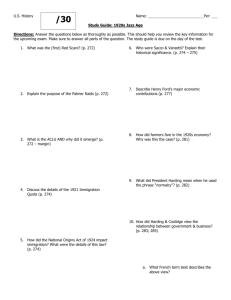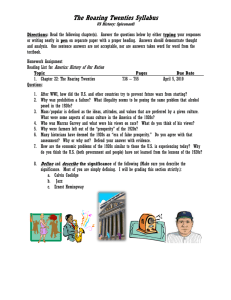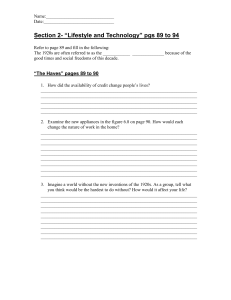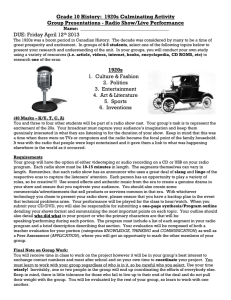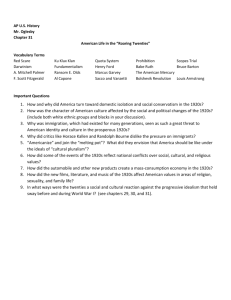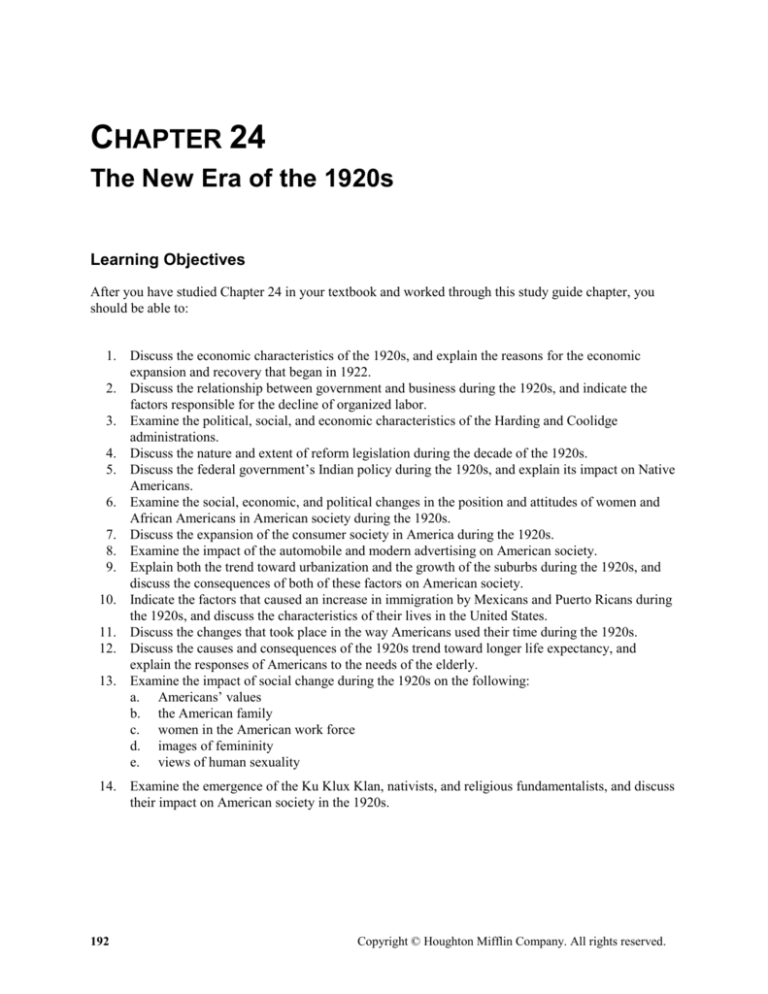
CHAPTER 24
The New Era of the 1920s
Learning Objectives
After you have studied Chapter 24 in your textbook and worked through this study guide chapter, you
should be able to:
1. Discuss the economic characteristics of the 1920s, and explain the reasons for the economic
expansion and recovery that began in 1922.
2. Discuss the relationship between government and business during the 1920s, and indicate the
factors responsible for the decline of organized labor.
3. Examine the political, social, and economic characteristics of the Harding and Coolidge
administrations.
4. Discuss the nature and extent of reform legislation during the decade of the 1920s.
5. Discuss the federal government’s Indian policy during the 1920s, and explain its impact on Native
Americans.
6. Examine the social, economic, and political changes in the position and attitudes of women and
African Americans in American society during the 1920s.
7. Discuss the expansion of the consumer society in America during the 1920s.
8. Examine the impact of the automobile and modern advertising on American society.
9. Explain both the trend toward urbanization and the growth of the suburbs during the 1920s, and
discuss the consequences of both of these factors on American society.
10. Indicate the factors that caused an increase in immigration by Mexicans and Puerto Ricans during
the 1920s, and discuss the characteristics of their lives in the United States.
11. Discuss the changes that took place in the way Americans used their time during the 1920s.
12. Discuss the causes and consequences of the 1920s trend toward longer life expectancy, and
explain the responses of Americans to the needs of the elderly.
13. Examine the impact of social change during the 1920s on the following:
a. Americans’ values
b. the American family
c. women in the American work force
d. images of femininity
e. views of human sexuality
14. Examine the emergence of the Ku Klux Klan, nativists, and religious fundamentalists, and discuss
their impact on American society in the 1920s.
192
Copyright © Houghton Mifflin Company. All rights reserved.
The New Era of the 1920s
193
15. Explain the characteristics of each of the following, and discuss the impact of each on American
society during the 1920s:
a. Games
b. Movies
c. Sports
d. Prohibition
16. Examine and evaluate the movements in American literature, art, and music during the 1920s.
17. Discuss the issues and personalities in the 1928 presidential campaign, and explain the election’s
outcome.
18. Discuss the events that led to the 1929 stock market crash, and examine the causes of the crash
and the Great Depression that followed.
Thematic Guide
The decade of the 1920s began with troubling economic signs but soon became an era of economic
prosperity for many Americans. Prosperity was accompanied by pro-business attitudes and unparalleled
consumerism. The federal government remained active in its support of business interests but became
more passive in its regulation of those interests. While the Supreme Court handed down antiregulatory
decisions and organized labor suffered setbacks, pro-business attitudes reminiscent of the Gilded Age
marked the Harding, Coolidge, and Hoover administrations. Most reforms took place at the state and
local levels. Interest in reform concerning Indian affairs led to the reorganization of the Bureau of Indian
Affairs, but Indian policy matters continued to be characterized by paternalism. Furthermore, while
newly enfranchised women lobbied and gained passage of some legislation helpful to them, women
generally struggled to find their political voice.
The consumerism of the age was fueled by the growing purchasing power of many American families
and the accompanying ability to acquire the goods associated with a consumer society. Both the
automobile and the sophisticated techniques of modern advertising transformed the American life style.
The urbanization of American society continued in the 1920s. Although movement to cities offered
opportunities to many, black migrants found that white racism was as prevalent in urban areas as it had
been in the rural South. However, blacks’ urban ghetto experience aroused their class and ethnic
consciousness, as seen both in Marcus Garvey’s black nationalist movement and in the cultural
outpouring known as the Harlem Renaissance. Racism also shaped the lives of Mexicans, Puerto Ricans,
and other newcomers to American cities and contributed to “white flight” from the inner city and to
suburban growth.
The way in which Americans spent their time changed. For instance, labor-saving devices lightened
the tasks of women working in the home. But since women were still expected to clothe and feed the
family and since few women produced clothes and preserved food at home, they spent their time
shopping for these goods and became the primary consumers in society.
Altered attitudes and values brought about by societal changes found expression in new clothing and
hair styles and in a new openness about human sexuality. Increased longevity resulting from improved
diets and improved healthcare led to an increase in the number of older Americans and to limited
attempts to respond to their needs. At the same time, compulsory-school-attendance laws increased the
influence of the peer group in the socialization of children. Furthermore, a combination of consumerism
Copyright © Houghton Mifflin Company. All rights reserved.
194
Chapter 24
and economic necessity caused more women, including married women, to work outside the home. The
work they performed and the wages they earned were largely determined by the sex-segregated
characteristics of the labor market and, for nonwhites, by racial bias. In spite of sexism and racism,
however, many women placed family needs above individual needs.
Many people felt threatened by change, and some, attempting to protect traditional attitudes and
values, reacted defensively, sometimes with attempts to blame change on scapegoats. The emergence of
the “new” Klan and the increase in nativism and fear of radicalism (evidenced in the Sacco and Vanzetti
case) can be seen in this light. Religious fundamentalism also gained strength, as the Scopes trial
revealed.
More leisure time and a search for entertainment meant that spectator sports and the movies became
big business. As the conformist aspects of mass culture caused individuality to fade, Americans found
heroes in sports figures, movie idols, and media-created personalities. Caught between two value
systems, many Americans gave lip service to the old, as evidenced in their professed support of the
Prohibition experiment, but chose the new, as the breakdown of Prohibition in the cities shows.
In literature, the 1920s saw the work of the Lost Generation and of the Harlem Renaissance. In
music, it was the age of jazz, America’s most distinctive art form, and of such talented composers as
Aaron Copland and George Gershwin. In architecture, Frank Lloyd Wright predominated. Overall, the
period stands as one of the most creative in American history.
In politics, the presidency remained in Republican hands in 1928 as most Americans affirmed their
confidence in the building of a New Era of prosperity for all. But with the stock market crash of 1929,
the optimism of 1928 gave way to concern and ultimately, with the onset of the Great Depression, to
despair. The Jazz Age ended. The American economic system would have to be rebuilt.
Building Vocabulary
Listed below are important words and terms that you need to know to get the most out of Chapter 24.
They are listed in the order in which they occur in the chapter. After carefully looking through the list,
refer to a dictionary and jot down the definition of words that you do not know or of which you are
unsure.
revered
beset
entice
quash
Copyright © Houghton Mifflin Company. All rights reserved.
The New Era of the 1920s
predatory
indignant
dilapidated
reminisce
chaste
torrid
reactionary
mete
wane
flout
hedonistic
fundamentalist
Pentecostal
pomade
deride
Copyright © Houghton Mifflin Company. All rights reserved.
195
196
Chapter 24
lament
exuberance
urbane
gregarious
edifice
collateral
lucrative
mores
emulate
Identification and Significance
After studying Chapter 24 of A People and a Nation, you should be able to identify fully and explain the
historical significance of each item listed below.
1. Identify each item in the space provided. Give an explanation or description of the item. Answer
the questions who, what, where, and when.
2. Explain the historical significance of each item in the space provided. Establish the historical
context in which the item exists. Establish the item as the result of or as the cause of other factors
existing in the society under study. Answer this question: What were the political, social,
economic, and/or cultural consequences of this item?
Copyright © Houghton Mifflin Company. All rights reserved.
The New Era of the 1920s
Charles A. Lindbergh
Identification
Significance
oligopolies
Identification
Significance
the “new lobbying”
Identification
Significance
Coronado Coal Company v. United Mine Worker
Identification
Significance
Bailey v. Drexel Furniture Company and Adkins v. Children’s Hospital
Identification
Significance
Copyright © Houghton Mifflin Company. All rights reserved.
197
198
Chapter 24
welfare capitalism
Identification
Significance
Warren G. Harding
Identification
Significance
Charles Forbes and Harry Daugherty
Identification
Significance
the Teapot Dome scandal
Identification
Significance
Calvin Coolidge
Identification
Significance
Copyright © Houghton Mifflin Company. All rights reserved.
The New Era of the 1920s
199
the McNary-Haugen bills
Identification
Significance
the 1924 presidential election
Identification
Significance
the Indian Rights Association, the Indian Defense Association, and the General Federation of Women’s
Clubs
Identification
Significance
Native Americans’ citizenship status
Identification
Significance
the Bureau of Indian Affairs
Identification
Significance
Copyright © Houghton Mifflin Company. All rights reserved.
200
Chapter 24
the Sheppard-Towner Act
Identification
Significance
the Cable Act
Identification
Significance
the National Woman’s Party
Identification
Significance
the automobile
Identification
Significance
the Federal Highway Act
Identification
Significance
Copyright © Houghton Mifflin Company. All rights reserved.
The New Era of the 1920s
The Man Nobody Knows
Identification
Significance
the radio
Identification
Significance
urbanization
Identification
Significance
Marcus Garvey
Identification
Significance
Mexican immigrants
Identification
Significance
Copyright © Houghton Mifflin Company. All rights reserved.
201
202
Chapter 24
Puerto Rican immigrants
Identification
Significance
the growth of the suburbs
Identification
Significance
the American family of the 1920s
Identification
Significance
home appliances and household management in the 1920s
Identification
Significance
the peer group and the socialization of children
Identification
Significance
Copyright © Houghton Mifflin Company. All rights reserved.
The New Era of the 1920s
women in the 1920s labor force
Identification
Significance
the flapper
Identification
Significance
homosexual culture
Identification
Significance
Ku Klux Klan
Identification
Significance
the Quota (Johnson) Act of 1921
Identification
Significance
Copyright © Houghton Mifflin Company. All rights reserved.
203
204
Chapter 24
the Immigration Act of 1924
Identification
Significance
the National Origins Act
Identification
Significance
Nicola Sacco and Bartolomeo Vanzetti
Identification
Significance
the Scopes trial
Identification
Significance
Pentecostal religion
Identification
Significance
Copyright © Houghton Mifflin Company. All rights reserved.
The New Era of the 1920s
mahjongg, crossword puzzles, miniature golf, and the Charleston
Identification
Significance
motion pictures
Identification
Significance
baseball
Identification
Significance
Jack Dempsey, Harold “Red” Grange, and George Herman “Babe” Ruth
Identification
Significance
Rudolph Valentino
Identification
Significance
Copyright © Houghton Mifflin Company. All rights reserved.
205
206
Chapter 24
Prohibition
Identification
Significance
Al Capone
Identification
Significance
the Lost Generation
Identification
Significance
the Harlem Renaissance
Identification
Significance
the Jazz Age
Identification
Significance
Copyright © Houghton Mifflin Company. All rights reserved.
The New Era of the 1920s
the 1928 presidential election
Identification
Significance
Herbert Hoover
Identification
Significance
Al Smith
Identification
Significance
Black Thursday
Identification
Significance
J. P. Morgan and Company
Identification
Significance
Copyright © Houghton Mifflin Company. All rights reserved.
207
208
Chapter 24
Black Tuesday
Identification
Significance
the stock market crash
Identification
Significance
Organizing Information
The 1920s are often characterized as a pro-business era. To help yourself analyze the validity of that
characterization, collect information from Chapter 24 concerning the support business, and especially
Big Business, was given both by government and the public during the 1920s that enhanced businesses’
potential to make lots of money and have an easier time doing it. Enter reminders of the information you
find in the appropriate blocks in the chart “Business Climate in the 1920s.” The chart includes an extra
row in case you find an additional factor that you think should be covered.
Copyright © Houghton Mifflin Company. All rights reserved.
The New Era of the 1920s
209
Business Climate in the 1920s
Contributors to the
Business Climate
Supreme
Court
Decisions
Legislation
Enacted by
Congress
Taxes
Tariffs
Regulation
Labor (Unions, Strikes,
Wages)
Consumer spending
(purchasing power,
encouragement of spending,
patterns of spending)
Copyright © Houghton Mifflin Company. All rights reserved.
Actions of the
President and
Others in the
Executive
Branch
Behavior and
Attitudes of the
Public
210
Chapter 24
Business Climate in the 1920s (continued)
Contributors to the
Business Climate
Supreme
Court
Decisions
Legislation
Enacted by
Congress
Actions of the
President and
Others in the
Executive
Branch
Behavior and
Attitudes of the
Public
Public Works Facilitating
Business
Financing: Investors,
Borrowing
Corruption: Bribery, Graft,
Scandal, Illicit Enterprises
Other:
Copyright © Houghton Mifflin Company. All rights reserved.
The New Era of the 1920s
211
Interpreting Information
Much of the information you found and recorded in the Organizing Information chart “Business Climate
in the 1920s” should clarify and support the contention that the 1920s was a very pro-business period in
American history, perhaps what could be called an excessively and dangerously pro-business period.
Using the information you gathered and organized, plan and compose a working draft of an essay on the
following question:
How did the federal government, financiers, and the public fan the kind of unreasonable
optimism about the future of American business and the kind of wild investing in it that
contributed in a major way to the stock market crash of 1929?
Ideas and Details
Objective 2
1. In Bailey v. Drexel Furniture Company, the Supreme Court
a. demonstrated a pro-business stance by striking down restrictions on child labor.
b. demonstrated that it was moving in a liberal direction in the field of consumer
protection.
c. declared federal aid to a particular industry unconstitutional.
d. upheld the right to strike by union members.
Objective 2
2. During the 1920s, organized labor
a. received support from many large corporations.
b. was encouraged by the rulings of a sympathetic Supreme Court.
c. continued to attract members in spite of the hostility of the federal government.
d. was hurt by the policy of welfare capitalism adopted by some large corporations.
Objective 3
3. One area of disagreement between President Coolidge and Congress was
a. federally funded internal improvements.
b. farm policy.
c. foreign policy.
d. military spending.
Copyright © Houghton Mifflin Company. All rights reserved.
212
Chapter 24
Objective 6
4. Which of the following is true of the National Woman’s Party during the 1920s?
a. It joined with organizations composed of AfricanAmerican women to fight for the
rights of minority women.
b. It campaigned tirelessly for enactment of sex-based labor legislation to protect
employed working-class women.
c. It encouraged women to engage in bloc voting.
d. It campaigned for an Equal Rights Amendment to guarantee women’s equality with
men in all parts of society.
Objective 6
5. Urban blacks were drawn to Marcus Garvey because he
a. emphasized racial pride.
b. promoted education as the route to assimilation.
c. preached against the evils of the free enterprise system.
d. was willing to use military means to achieve his objectives.
Objectives 6, 7, and 11
6. New technology changed the role of housewives in which of the following ways?
a. Management of the household became a shared family responsibility.
b. The housewife became the family’s chief shopper rather than its chief producer.
c. Fewer child-raising responsibilities were placed on the housewife.
d. Housewives began to be seen as specialists in certain tasks.
Objective 13
7. As a consequence of child-labor laws and compulsory-school-attendance laws,
a. daily newspaper circulation increased dramatically in the 1920s.
b. consumption of consumer products began to decline in the 1920s.
c. the role of the family in socializing children declined while that of the peer group
increased.
d. many industries faced a severe labor shortage.
Objectives 6 and 13
8. Which of the following statements concerning women in the work force during the
1920s is correct?
a. The number of women in factories increased dramatically.
b. Sex segregation in the workplace became less noticeable.
c. The number of women in the work force declined.
d. Married women joined the work force in increasing numbers.
Objective 14
9. During the early 1920s, the Ku Klux Klan
a. had little power outside the South.
b. lost most of its power in the South because of the new mood of militancy among
blacks.
c. gained power nationally as an anti-black, anti-immigrant, anti-Catholic movement.
d. was outlawed by Congress as a terrorist organization.
Copyright © Houghton Mifflin Company. All rights reserved.
The New Era of the 1920s
213
Objective 14
10. Which of the following conclusions may be drawn from the Sacco and Vanzetti case?
a. The fear of radicalism, which caused the Red Scare, had disappeared.
b. In the future, immigration laws would be applied equally to all ethnic groups.
c. Blacks could not be guaranteed a fair trial in the South.
d. Justice was not necessarily blind to a person’s political beliefs or ethnic
background.
Objective 15
11. Jack Dempsey, “Babe” Ruth, and Rudolph Valentino demonstrate that the decade of the
1920s was an
a. age of heroes.
b. era of great actors.
c. era of great baseball players.
d. age of lawlessness.
Objective 15
12. Prohibition failed because
a. Americans completely rejected the value system out of which it was born.
b. illegal liquor was foisted on the public by organized crime.
c. it hurt the nation economically.
d. many people were willing to break the law in their quest for pleasure and their
desire for personal freedom.
Objective 16
13. Many writers of the Harlem Renaissance
a. rejected the African past of black Americans.
b. advocated that black Americans return to Africa.
c. rejected white culture.
d. were mainly interested in economic issues.
Objective 17
14. The election of 1928 indicated that
a. the Democrats were gaining strength in urban areas.
b. the Democrats were losing their stronghold in the South.
c. the Republicans were making gains in all sections of the country.
d. the Republicans had become the minority party.
Objective 18
15. The government contributed to the stock market crash of 1929 and to the depression
that followed in which of the following ways?
a. Government regulations imposed on businesses reduced profits and investments.
b. Tax policies before the crash took large sums of money out of circulation.
c. The Federal Reserve Board followed an easy credit policy in the years prior to the
crash.
d. Government policies toward organized labor encouraged large wage increases and
inflation.
Copyright © Houghton Mifflin Company. All rights reserved.
214
Chapter 24
Essay Questions
Objective 1
1. Discuss the factors responsible for the economic recovery that began in 1922. How long did this
economic recovery last? Why is it said that this recovery was “uneven”?
Objective 2
2. Examine the relationship between government and business during the Republican era of the
1920s. What was the philosophy behind this relationship?
Objective 4
3. Examine the attitude toward reform during the 1920s, and discuss and assess the reforms that
were achieved during the decade.
Objective 8
4. Discuss the impact of the automobile on American society, American values, and the American
family.
Objective 6
5. Explain the emergence and the rise to power of Marcus Garvey.
Objectives 13 and 14
6. Defend the following statement, and explain how it applies not only to the 1920s but to the
twenty-first century as well: “The emotional responses that Americans made to events during the
1920s were part of a larger attempt to sustain old-fashioned values in a fast-moving, materialistic
world.”
Objective 18
7. Explain why the 1929 stock market crash led to the Great Depression.
Copyright © Houghton Mifflin Company. All rights reserved.

